Insignia ranks of the Russian Army. XVIII-XX century. Epaulettes
Epaulettes on the Russian military uniform appeared in their unique meaning and official name:
* On the uniform of the lower ranks of the Lancers in the 1801 year.
* On the officer's uniform in 1807.
* On the form of the lower ranks of the dragoon regiments in 1817g.
In 1827, epaulettes become a means of distinguishing between officer and general officers.
In 1843, epaulettes become a means of distinguishing the ranks of the lower ranks of the lancer and dragoon regiments.
From 1854-56, epaulets for officers and generals remain the property of only certain types of uniform.
In 1882, the lower ranks of the army dragoon regiments lose their epaulettes. Army lancers transformed into dragoons and thereby lose their epaulettes too.
In the 1908 year, with the revival of the army lancers, epaulettes to the lower ranks were returned. There are no lower ranks of dragoons.
In 1917, epaulets on a Russian Army uniform are canceled forever.
End of resume.
Epaulettes as an element of military uniforms in the Russian Army appeared much later than shoulder straps. And also, like shoulder straps, for a long time (up to 1827) they did not play the role of determinant of ranks.
From the author. The widely held view that epaulets lead from certain "shoulder plates that protected the shoulders from saber blows" is deeply mistaken. Epaulets on the shoulders of warriors appeared after at least a hundred years after they refused to wear armor. And what, all these hundred years, the soldiers suffered blows with swords on the shoulders, and then suddenly remembered about the "shoulder plates"? And why then shoulder straps "revived" not in the form of metal strips, but in the form of rag valves?
And epaulettes, more reminiscent of the type of armor protection of the shoulder joint than epaulets, appear even later. The external and very remote similarity of epaulettes or epaulettes with the ancient elements of armor is not yet the basis for something to assert. Associations are a very flimsy argument.
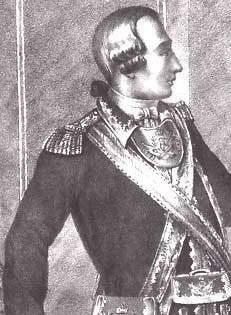 If the epaulet appears on Russian military clothing in the 1700 year under the name "Garus cord", then something similar to epaulettes appears on the shoulders of soldiers and officers only during the reign of Empress Elizabeth (1741-1761). And then only in the Life Campaign
If the epaulet appears on Russian military clothing in the 1700 year under the name "Garus cord", then something similar to epaulettes appears on the shoulders of soldiers and officers only during the reign of Empress Elizabeth (1741-1761). And then only in the Life CampaignHelp. In the palace coup 25 in November 1741 of the year, during which the emperor John Antonovich (son of Grand Duchess Anna Leopoldovna) was deposed and Elizabeth was enthroned, the grenadier company of the Life Guards Regiment played a decisive role. The new empress generously rewarded those who enthroned her. She transformed the company into a particularly privileged part - the "Life Campaign", which carries a personal security service for her person. All the soldiers of the company received nobility and soldiers' rank in this company was equal to the rank of second-lieutenant of the army. The officers were equated to the army generals. The rank of captain of the Life Campaign was assumed by the empress herself. After her death in December 1761. Emperor Peter III at the beginning of 1762. He returned the Life Campaign to the Preobrazhensky Regiment as an ordinary Guards Company.
The picture on the left: Officer Life Campaign.
The comment is off topic. It is generally accepted that the Life Guards were the personal guards of the royal persons, consisting of especially close loyal soldiers and officers who were ready to give their lives at any time for the sake of the rescuer.
Guard they were guarded, but if you carefully look at stories Life Guard and its officer corps, then there is a feeling that this was probably not a defense, but a prison convoy.
The Life Guards were rather an instrument of the highest aristocracy, which allowed them to hold emperors firmly in their hands and dictate their will. It is not by chance that most of the Guards officers, and the commanders of the Guards regiments, almost all were from among the highest nobility.
In the 18th century, all Russian tsars (not excluding Peter I himself) were either imprisoned on the throne or overthrown from it by the hands of the Life Guards.
The emperors of Russia were not autocrats, as is commonly believed. They made all the decisions based not on the interests of the state or their own opinions, but on the interests of the high society nobility. And if one or another emperor did not arrange those, then his days on the throne were numbered. They were captives of the highest aristocracy.
Nicholas I was the first who managed to bend the Russian elite under him. The events on 14's Senatskaya Square in December. 1825 was not at all "the first revolutionary performance of the best people of Russia." It was a failed attempt by the high society nobility to set on the throne not Konstantin, who was energetic and imperious, but sluggish, weak-willed and obedient to the high society. The last attempt inexorably losing its value in the life of the country of the nobility to retain its influence on the throne.
It is likely that the overthrow of Nicholas II in 1917 was due to the fact that the impoverished and lost their economic, and hence the political significance of the higher nobility did not want to give up the management of the emperor of the rapidly developing bourgeoisie. But the bourgeoisie (merchants, industrialists) did not see any other way to take away the real political power except to change the regime of autocracy to parliamentarism.
The creators of the well-known work "The Historical Description of Clothes and Armament of the Russian Forces" (Part Three), describing the clothes of the Russian Army, found it difficult to name the product precisely. Obviously, he could not find a regulatory document in this regard. They call it "epaulets or epaulets" because in appearance they resemble epaulets more, and in design epaulets of the first half of the 18th century. However, it is obvious that these epaulet epaulettes are only a decorative element of the uniform exclusively of the Life Campaign and do not carry a semantic load.
1763 year.
24 April 1763 in musketeer (infantry) and grenadier regiments, in carabinier regiments, in field battalions, in artillery, in miner and pioneer companies, and from 1765 year and in newly established jaeger regiments on the left shoulder it is prescribed to have “epon or opolet” . We quote:
"On the left shoulder, to distinguish between the shelves, a yarn or woolen epaulet or epaulette was sewn, commanded by the regiment by sight and colors. This epaulet with the underside was attached at the shoulder connection with the sleeve, and fastened with a small cut through the upper loop copper button under the caftan collar. "
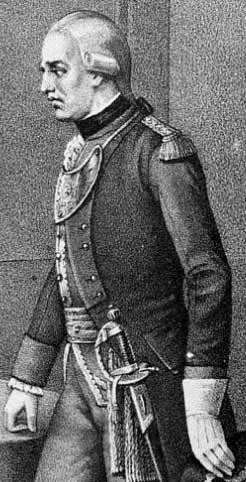 In the 1764, the epaulet or epaulette on the left shoulder will be given to the dragoons and cuirassiers.
In the 1764, the epaulet or epaulette on the left shoulder will be given to the dragoons and cuirassiers.However, this “epaulet or epaulet” has on all clothes ranks from private to colonel inclusive. Those. at this time, he does not play the role of the determinant of ranks and is not a distinction between officers.
The figure on the right shows an officer of an infantry regiment. The signs of his officer dignity are the officer's scarf on his belt and his throat (neck mark, badge, officer badge), which we see on the chest.
On his left shoulder, we see "epaulet or epaulet," which since 1763 has been fulfilling the task of identifying servicemen in regiments or as it was written then, "... so that the shelves have some kind of external difference one from another."
It is described as follows:
* towel or braid length shoulder length 1 widths (4.4 cm.),
* hoop (transverse interception),
* brush length 1-2 top (4.4-8.8 cm.).
These so-called towels and hoops were woven from braid and cords of various colors. A brush of cords also in various colors.
However, the “epaulet or epaulet” of the lower ranks and officers differed from each other in quality. If the lower ranks used wool for the epaulet, then the officers used gold and silver yarn instead of white and yellow wool.
By the time the Historical Description was published, volume four, the archives contain drawings of only twenty-seven infantry (musketeers) regiments. However, these drawings cannot be considered a means of defining a regiment, since, as stated above, ".... the epaulet or epaulette, the type and colors of the commanders of the regiment". Those. the regiment commander himself decided what shoulder strap the regiment should wear. The commander has changed, and epaulets change.
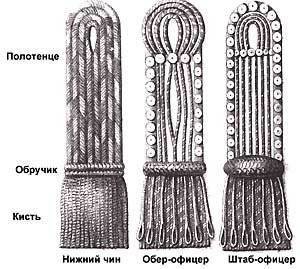 Therefore, we give only one example - “epaulets or epaulets” of ranks of the Apsheron Infantry Regiment (in the figure on the right).
Therefore, we give only one example - “epaulets or epaulets” of ranks of the Apsheron Infantry Regiment (in the figure on the right).From the author. Let the reader decide for himself that it is a shoulder strap or an epaulette. The author still believes their epaulets, based on the design. Hanging at the end of the brush, which covers the shoulder, is not yet reason to believe this epaulette. Although the resemblance is fair. A real epaulette, which will appear at the beginning of the 19th century and will last until the second decade of the 20th century, will differ greatly in its design.
However, in the 18th century, epaulet-epaulets will play only a decorative role as a means of distinguishing servicemen from one regiment from another. Note that it is extremely difficult, if not impossible, to determine the specific regiment by the type of epaulette-epaulette.
These epaulettes epaulets Russian soldiers and officers will wear until the accession of Emperor Paul I. The change of uniform, produced by Paul, will eliminate them.
It can be said that the background story of the epaulette that began in the 1741 year will end in 1796.
17 September 1807 years - the birthday of real officers epaulettes of the Russian Army. True, the day before, namely 16, in September, 1807, one epaulet on the left shoulder, is received by generals and officers of Sweat of His Imperial Majesty. On their right shoulder they have an aglet. When they get two epaulettes, it remains unclear. The historical description on this subject is silent.
We quote:
"...- the generals and headquarters and the chief officers of the Grenadier regiments, instead of shoulder straps, are commanded to wear epaulettes, with a field woolen in the color of these shoulder straps. One half of the field, closest to the collar, was sheathed in a narrow, gold braid, and at the edges another , superimposed two gold tow ...
The headquarters officers had epaulets with thin, and the generals with thick, fringed fringes, and all of them even passed through the pogrom or counter-flight from the same galloon that was on the epaulets, buttoning it sewn to the uniform at the collar. "
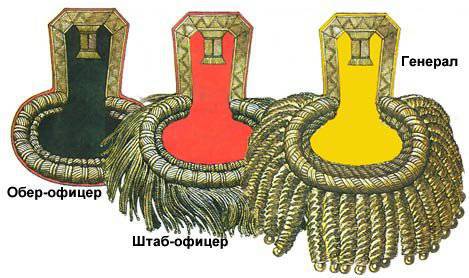 In this quote, I completely preserved the spelling of that time, replacing only letters that are not in our alphabet now.
In this quote, I completely preserved the spelling of that time, replacing only letters that are not in our alphabet now.The picture on the left shows the epaulettes arr. 1807 of the year.
Please pay attention to the shape of the epaulet. The root is not rectangular, as it will be later, but tapering to the field. Also the field is not round, but oval.
The generals of the epaulette field are also cloth, and not golden, as will be done later. Also on epaulettes there is no encryption.
Encryption of gold or silver cord (for the regimental instrument metal) indicating the division number will be entered on 19 December episodes. 1807g only.
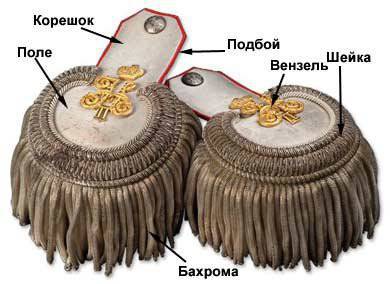 Reference. An epaulette consists of a spine, field, neck, fringe, and lining.
Reference. An epaulette consists of a spine, field, neck, fringe, and lining.The root is the upper part of the epaulette. In the upper end of the spine there is a buttonhole (slot) with the help of which the epaulet is fastened to the button sewn at the collar of the uniform. The bottom edge of the spine goes into the field.
The field is the oval or round part of the epaulette. Encryption and / or monogram are placed on the field.
The field and the root of the army epaulettes are woven in color like the epaulets of the lower ranks. The field and the back of the guard epaulettes, as well as the general's epaulettes entirely gold or silver
The neck is three or four gold or silver braids enveloping the field of the epaulette.
Fringe is a gold or silver bother hanging from the neck. Ober-officer epaulets have no fringe, headquarters officers have thin, and generals have thick fringe.
Underlay is cloth lining epaulette. The color is the same as the color of the field and the spine. If the regiment has a vypushka on shoulder straps, then the color of the bottoming is an epaulet of the color of the edging.
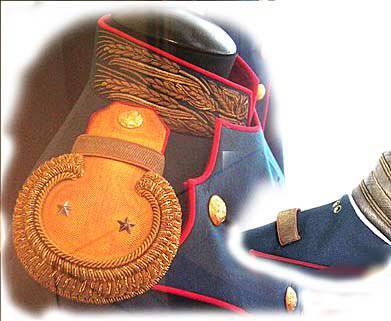 On the uniform, an epaulet of the spine is passed under the bow of the neck (at different times it was called the driver, counter-flight, kontrgogonchik), which is sewn on the shoulder of the uniform and the spine is attached to the button on the shoulder of the uniform at the collar.
On the uniform, an epaulet of the spine is passed under the bow of the neck (at different times it was called the driver, counter-flight, kontrgogonchik), which is sewn on the shoulder of the uniform and the spine is attached to the button on the shoulder of the uniform at the collar.Ie, the epaulette lies on the shoulder completely free and fixed only with a button. It is held back by the counterguiser from sliding forward or backward.
On the photo to the right: Epole-Lieutenant of the Life Guards Volynsky Regiment. The field of the epaulette is golden, as it should be in the guard (instrument color of the Volynsky regiment is gold). Silver stars. It is clearly visible that the epaulet of the spine will be threaded under the counterguard. There are no encryptions or monograms on the epaulette. After all, there were no encryption in the guard, and monograms were worn only in the companies of His Majesty. The right of the picture shows the shoulder of the uniform without an epaulet with a sewn galunny counterfeiter.
The end of the reference.
From the author. It was believed that the button is sewn to the shoulder of the uniform, and the epaulet with its slot in the spine is fastened to the button. However, practiced a completely different way of mounting the epaulette. The button with its eyelet was inserted from above into a very small hole in the epaulette. A lace passed through the loop through the loop. On the shoulder of the uniform at the collar were made two holes, trimmed with metal rings (grommets). The epaulette slipped under the counterferee, the lace was threaded into the grommets and tied inside the uniform.
However, the officers' shoulder straps were also usually used this way. The fact is that the officers and shoulder straps and the epaulette are pretty tough and it is difficult to fasten them to a button. And the epaulet takes a sloppy look, if you use the official method of fastening.
By the way, please pay attention to the collar. In the Guards, each regiment had only the assigned sewing on the collar of his uniform. Very expensive (more expensive than the uniform itself). Therefore, it is very easy to identify the person depicted in photographs and pictures.
On the same day of September 17, 1807 epaulettes were distributed to infantry (musketeers), chasseurs, cuirassier, dragoon, and uhlan regiments.
Foot and horse artillery (officers and generals) will receive epaulets only 3 January 1808. The field and spine are red, the brim of the spine, the neck and the fringe are golden. Gold cord encryption is the number of the artillery brigade. Artillery generals have epaulettes without encryption.
Garrison artillery (officers and generals) will receive epaulets only 22 November 1808 of the year.
Officers and generals of the sapper and pioneer units will receive epaulettes like the 3 artillery of January 1808. The field and the spine are red, the brim of the spine, plaits and silver fringe. Silver cord encryption is the battalion number. The engineering generals have no encryption epaulets.
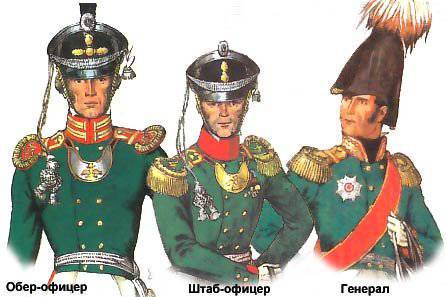 31 January 1808 year epaulettes get the generals and officers of the Corps of Engineers (field and garrison engineers. But the field and root of the epaulette are entirely silver, not cloth.
31 January 1808 year epaulettes get the generals and officers of the Corps of Engineers (field and garrison engineers. But the field and root of the epaulette are entirely silver, not cloth.16 May 1808 epaulettes receive garrison regiments and battalions.
Thus, epaulettes immediately become a means of determining the rank of a rank — an chief officer, a staff officer, or a general. But it is impossible to determine the specific rank of an epaulet officer during this period. This could be done only for Gorzhet. But their officers were worn only in the ranks. The ranks of the generals among themselves was completely impossible to distinguish, since the generals had no gorges. Stars on epaulets will appear only in 1827 year.
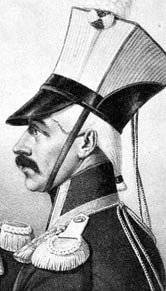 Recall that the color of epaulets of the lower ranks, and accordingly the color of the field and the spine of officers' epaulet was determined in the infantry by the order number of the regiment in the division:
Recall that the color of epaulets of the lower ranks, and accordingly the color of the field and the spine of officers' epaulet was determined in the infantry by the order number of the regiment in the division:The first regiment of the division is the red field,
The second regiment of the division is a white field,
The third regiment of the division is the yellow field,
The fourth regiment of the division is dark green with a red vypushkoy,
The fifth regiment of the division is the blue field.
Within the framework of the article, it is not possible to describe all the colors of the epaulette fields in the shelves of other types weapons. I recommend to apply for help in articles describing epaulets of the XIX century.
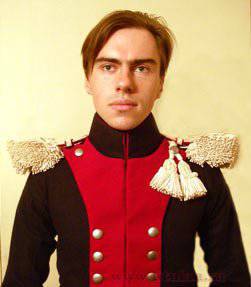 It is curious that on the same day of September 17 1807 epaulettes were given to the lower ranks of the Uhlan regiments. Only the fringe of them was not hanging, but thick and hard.
It is curious that on the same day of September 17 1807 epaulettes were given to the lower ranks of the Uhlan regiments. Only the fringe of them was not hanging, but thick and hard.Anticipating objections, I will say that this is stated in the Historical Description (Part 11, p. 71).
In the picture on the right: non-commissioned officer of the Lithuanian Uhlan regiment.
Some picture of the epaulets of the lower ranks of the Ulan regiments is provided by a photograph (left) from the VIK Lithuanian Ulansky Regiment website (reconstruction).
So it should be borne in mind that in the XIX century epaulettes were not exclusively belonging to the officer's uniform. Somewhat later, except for the lower ranks of the Ulan regiments, epaulets will appear in the lower ranks of the dragoon regiments (1817).
And the main sign of the officer rank throughout almost the entire XIX century will be the officer's scarf.
In army cavalry, epaulets for officers and generals were introduced in the same manner as in the guards cavalry. Of course, the field and the root of the epaulette was cloth, as in the whole Army. At the same time, hussar officers began to wear epaulettes only on vice-uniforms, and epaulets would never appear on dolomans and matiques.
Guard
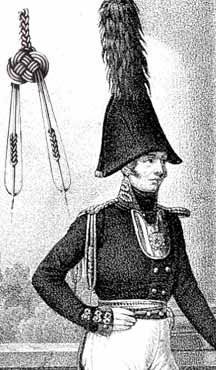 On the same day as in the Army, i.e. 17 September 1807 Guard received an epaulette. But unlike the Army, there is only one on the left shoulder. On the right shoulder remained the aglet. And only 27 in March, 1809, officers and generals of the guard received epaulettes on both shoulders, having lost at the same time an aglet.
On the same day as in the Army, i.e. 17 September 1807 Guard received an epaulette. But unlike the Army, there is only one on the left shoulder. On the right shoulder remained the aglet. And only 27 in March, 1809, officers and generals of the guard received epaulettes on both shoulders, having lost at the same time an aglet.From the author. Due to the fact that the upper wicker part of the agletbane rests entirely on the shoulder, this is misleading for many uniformers. They believe that this is a shoulder strap or a special epaulette. However, the Historical Description unequivocally calls this element of the uniform on the right shoulder an aglet and supports the text with a pattern, where the aglet is shown completely separate.
The field and the root of the epaulette in the Guards infantry are entirely golden.
17 September 1807 epaulettes on the left shoulder were officers of the Guards heavy cavalry. In the Life Guard Equestrian Regiment, the field and the root of the epaulette are golden, and in the Cavalry Guard Regiment silver.
27 March 1809, the officers and generals of these regiments received epaulettes on both shoulders, losing the aglet.
At the same time, officers and generals received epaulettes in the Guards Hussars. Hussar officers began to wear golden epaulettes only on Vice-uniforms, and epaulets would never appear on dolomans and matiques.
When the Life Guards of the Ulansky Regiment were formed in 1809, the officers and generals of the regiment received the same epaulettes as the rest of the Guards cavalry.
Guards artillery (officers and generals) received epaulettes in the same manner and on the same dates as the rest of the guard.
The officers and generals of the Life Guards Sapper Battalion, when they were formed in December 1812, received the same epaulettes as the Guards artillery, but silver, not gold.
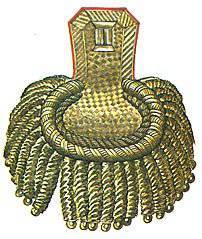 From January 26 to 1808, the epaulets of all the generals, regardless of the Rodor, become the same. The field and the root of the epaulette are a golden mat of a small-patterned pattern, podboy red, golden twisted fringe, immediately received the everyday name "caterpillars". The root of the epaulette is sheathed with a narrow galloon.
From January 26 to 1808, the epaulets of all the generals, regardless of the Rodor, become the same. The field and the root of the epaulette are a golden mat of a small-patterned pattern, podboy red, golden twisted fringe, immediately received the everyday name "caterpillars". The root of the epaulette is sheathed with a narrow galloon.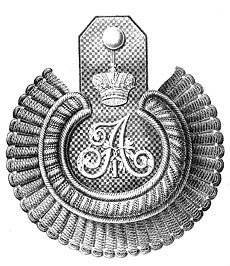 From time to time, different types of monograms will appear on the epaulette field, and, much later, asterisks, meaning the general's rank.
From time to time, different types of monograms will appear on the epaulette field, and, much later, asterisks, meaning the general's rank.On the picture to the right: a general's epaulet obr. 1808g.
Obviously, the Adjutant General in 1813 received the imperial consignment note for metal impregnations first on epaulets.
On the left: adjutant general epaulet arr. 1813 in the monogram of Emperor Alexander I. Notice that the epaulette root is no longer covered with gold lace.
In February, the 1817 of the year, the lower ranks of the dragoon army regiments and the Life Guards of the Dragoons regiment receive epaulettes of the cord. Thus, the epaulettes by this time are officers, generals of all types of troops and the lower ranks of the Ulan and dragoon regiments.
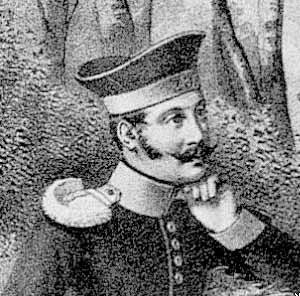 On the picture to the left: the common dragoon of the Kinburn Dragoon Regiment. In the shelves where the instrument metal was gold, the epaulettes of the lower ranks were wool yellow, and in the shelves where the instrument metal was silver, they were white.
On the picture to the left: the common dragoon of the Kinburn Dragoon Regiment. In the shelves where the instrument metal was gold, the epaulettes of the lower ranks were wool yellow, and in the shelves where the instrument metal was silver, they were white.In December 1825 of the year on the epaulettes of the officers of the Grenadier His Royal Highness Prince Eugene of Wirttemberg instead of the usual encryption appears his monogram under the crown.
The author was unable to find information about the existence of other monograms on epaulettes at this time, except for the monogram of Emperor Alexander I on the epaulets of adjutant generals. Apparently, the appearance of Prince Eugene's monogram on epaulets instead of the usual number or letter encryption marked the beginning of this practice.
And in January 1826 appears the second monogram on the epaulettes. This time they received the Moscow Grenadier Regiment, which, on the occasion of the appointment of the Highest Chief, now became known as the Grenadier Prince Paul of the Mecklenburg Regiment.
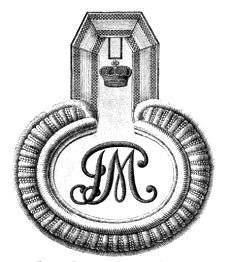 In the picture on the right: the officer’s epaulette of the Grenadier Regiment with the monogram of Prince Paul of Mecklenburg.
In the picture on the right: the officer’s epaulette of the Grenadier Regiment with the monogram of Prince Paul of Mecklenburg.From the author. This is somewhat later the highest patronage will become just an honorary title and will give the right to wear a regimental uniform. And in the first half of the XIX century, the Highest Chief was largely responsible for the condition of the regiment, obliged to take care of his well-being, to allocate his own funds to improve the lives of his officers and soldiers. He is obliged to visit the regiment periodically, to know the officers of the regiment personally. So patronage was not only an honor, but also a hefty burden.
I recall that the field and the root of the epaulettes in the grenadier shelves for this period were yellow. In the Moscow regiment, there is a dashboard metal, and accordingly a gold tail and a tail of an epaulet. The monogram is also gold embroidered or metal consignment note.
Please note that in 1825, the root of the epaulette is already rectangular and not tapering. But the field is still not round, but oval, as it was in epaulet obr.1807g.
1827 year.
January 1 1827 of the year was a milestone in the insignia of the ranks of the Russian Army. If until that day, the officers 'ranks could be distinguished only by horzhets (breastplates, cervical, officers' marks), and even then only in the ranks (they were worn only when they were in the ranks), now the insignia of the officers and generals in all branches of the military stars on epaulets.
Asterisks metal forged the color of the reverse instrument metal. Those. on gold epaulets silver, and on silver gold.
From the author. The historical description does not give the size of stars. According to one secondary data for all ranks, the size of the stars is the same - 1 / 4 top (11 mm.). According to some other data, not 11, but 13 mm. The author is inclined to consider the size of 11 mm. more true because it is almost exactly the 1 / 4 top. Indeed, at that time, all such sizes were counted in lobes of the top. If we try to figure out the size of 13 mm. In the versions, it turns out that the 4 / 16 topline is 11.1mm, and the nearest larger size 5 / 16 topline is 13.875mm., Rounded 14 mm. So to say, the stakes smaller than 1 / 8 have never been used.
The highest order was determined by the number of stars on the epaulettes:
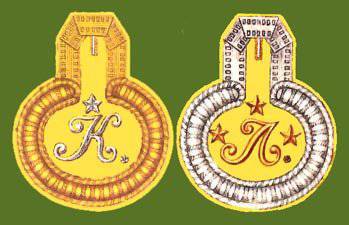 * 1 asterisk - ensign,
* 1 asterisk - ensign,* 2 asterisks - second lieutenant,
* 3 asterisks - lieutenant,
* 4 asterisks-shtab-captain,
* no stars - captain
* 2 asterisks - major,
* 3 stars - Lieutenant Colonel,
* no stars - Colonel,
* 2 asterisks - Major General,
* 3 stars - Lieutenant-General,
* without asterisks - general (..from infantry, ... from cavalry, ... from artillery, general engineer).
On the picture to the right: an epaulet of an ensign of the Kiev Grenadier Regiment and an epaulet of Lieutenant Lutsk Grenadier Regiment.
Asterisks were placed on the sides of the encryption, and the third and fourth above the encryption.
I remind you that the rank category (chief officer, head officer, general) was determined by the fact that the chief officers did not have fringe on epaulets, the head officers had thin fringe, and generals had thick.
I also remind you that in the infantry regiments the colors of the epaulette field depended on the number of the regiment in the division, and numbered codes indicating the number of the regiment were placed on them. Or the monogram of the Highest Chief.
From the author. So it remains unknown why the major and major general received two asterisks instead of one, although it would be more logical to start in each group of ranks with one asterisk or according to the German system - the junior rank in each category without asterisks. But now there is no one to ask about it. The creators of this system long ago went into oblivion.
The distinction of officer ranks by the number of stars on the epaulettes, and later on the shoulder straps, will remain unchanged in the Russian Army until December 16 1917, when the new government does not abolish the ranks themselves and all the insignia.
Is that in 1884 year will be canceled the rank of major and staff officer ranks will begin immediately with three asterisks (lieutenant colonel).
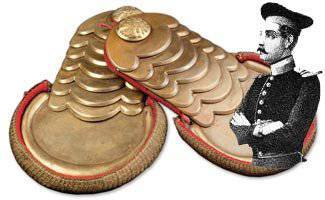 During the reign of Nicholas I, quite a few monograms of the Highest Chefs and others will appear on officers' epaulets. This "fashion" will continue under other emperors. Moreover, some of the regiments of the Russian Army in their time of existence will be replaced by five to six monograms. Therefore, we will not describe them here.
During the reign of Nicholas I, quite a few monograms of the Highest Chefs and others will appear on officers' epaulets. This "fashion" will continue under other emperors. Moreover, some of the regiments of the Russian Army in their time of existence will be replaced by five to six monograms. Therefore, we will not describe them here.October 13 1827, the lower ranks of the army dragoon and Uhlan regiments on uniforms instead of woolen epaulettes with fringe, introduced epaulettes of new design (scaly without fringe with cloth underlay and woolen countersong according to the collar color of the uniform.) There is one line, I have to use the line pattern, I am using the color of the collar, in the uniform of the uniform of the collar. metal on the color of the instrument metal shelf (yellow or white metal. Under the color of the collar of his uniform.
In the picture on the right: epaulettes of the lower ranks of army dragoon regiments arr. 1827
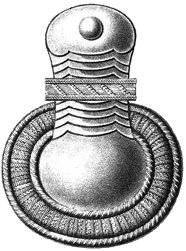 Army officers dragoon and lancers of the regiment 13 of October are also assigned scaled epaulettes, but of a slightly different kind. In general, the design repeats the design of the infantry epaulettes, but the spine is covered with metal scales, and the field is a convex plate. Kontropogonchik galunnogo pattern, which will later be called the "page drill". On the field, as well as on infantry epaulets, asterisks and ciphers or monograms are placed.
Army officers dragoon and lancers of the regiment 13 of October are also assigned scaled epaulettes, but of a slightly different kind. In general, the design repeats the design of the infantry epaulettes, but the spine is covered with metal scales, and the field is a convex plate. Kontropogonchik galunnogo pattern, which will later be called the "page drill". On the field, as well as on infantry epaulets, asterisks and ciphers or monograms are placed.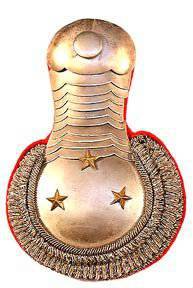 Also, as well as infantry dragoon officer epaulettes have a neck from twisted plaits, and staff officers and generals have a fringe.
Also, as well as infantry dragoon officer epaulettes have a neck from twisted plaits, and staff officers and generals have a fringe.In the picture on the left: Epole officer dragoon arr. 1827 with kontroponchikom. Encryption and asterisks are not shown.
On the photo to the right: an epaulet of the lieutenant of the dragoon regiment obr.1827g. The field and scales on the spine are silver, golden stars. Undercut red on the instrument color shelf.
In April, the 1843 of the year in infantry and other branches of the military introduced insignia in the form of transverse stripes on shoulder straps. Similar stripes appear on the epaulets of the lower ranks of the dragoon and uhlan regiments. Both army and guards. These stripes are sewn on top of the cloth counterferee, the width of which is made depending on the number of stripes that are not in it.
Note. In the cavalry of this period, the senior sergeant is the infantry sergeant, the junior sergeant is the senior noncommissioned officer in the infantry. A dragoon noncommissioned officer is equal to the younger noncommissioned officer in the infantry.
End notes.
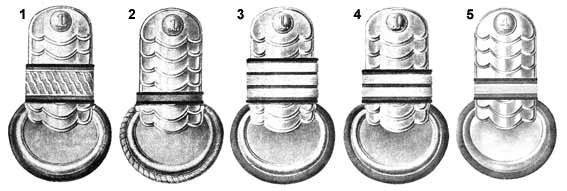
1) The senior vakhmistrov has a wide golden bridle of the "half-tab" pattern,
2) At the waist-junkers and junkers - narrow gold brooch of the picture "army"
3) The junior vakhmistrov has a narrow white wool bass, sewn into the 3 series.
4) The non-commissioned officers have the same and also sewn two-row tambourine.
5) At the base of the corporal - the same and similarly stitched bason in one row.
Note that on their overcoats the lower ranks of the dragoon and lancer regiments were worn epaulets, as in other branches of the military. The patches on the ranks on the dragoon and Uhlan shoulder straps were similar to those sewn on epaulets, but naturally, without a counter raid.
April 29 1854 The second milestone date in the history of epaulette. They are beginning to give way to officer uniform. Military officers' military overcoats with a soldier's uniform and officer uniform are introduced for military officers. Until that time, officers and generals wore epaulettes on all types of uniforms, excluding uniforms, on which they wore nothing on their shoulders.
And on March 12, Emperor Alexander II, who came to the throne, ordered 1855 to replace the epaulettes with epaulets on newly introduced Vic semi-caftans for everyday wear.
In the period between 1854 and 1859 for years, epaulettes become an accessory only for uniforms when they are worn as a parade or weekend. At the same time, if the officer wears shoulder straps, then the counterguest is located under the epaulet (at first it was ordered to pass the epaulette under the counterguise as the epaulette). And if you need to wear epaulettes, then epaulets will come off and epaulettes will be put on.
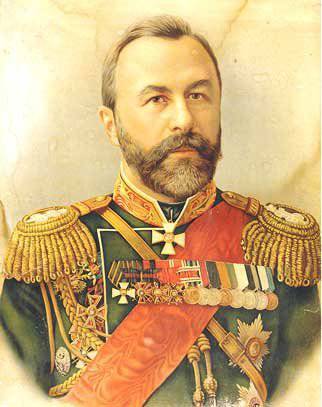 On the picture to the left: Adjutant General A.N. Kuropatkin in parade uniform with epaulets. War Minister 1898-1904
On the picture to the left: Adjutant General A.N. Kuropatkin in parade uniform with epaulets. War Minister 1898-1904In 1857, in March, the types and colors of epaulettes of army units were determined (Order of the Military Department No. XXUMX 69). Epaulettes wear:
* The generals listed in the army infantry, army cavalry and field artillery, with a general-general Vic-half-caftan with galloons - a golden fabric epaulet; The color of the undercoat is epaulette red.
* Generals listed in the Corps of Engineers, with a general-wide Vic-half-caftan with galloons - a field of epaulettes of silver cloth; The color of the undercoat is epaulette red.
* Generals and officers of the General Staff - a field of epaulettes of silver cloth; The color of the undercoat is epaulette red.
* Generals and officers of the surveyors' corps - a field of epaulettes of silver cloth; the color of the underlay is an epaulet of light blue.
The generals and officers of the Ministry of War and its subordinate institutions — the field of epaulettes for those who consist of light cavalry, scaly, and those who are composed of heavy cavalry and infantry — are made of silver fabric; the color of the undercoat is epaulette red.
* Generals and officers of the cuirassier regiments - a field of epaulette of golden or silver cloth; color podboy epaulet on color epaulet.
* All the ranks of the dragoon and Uhlan regiments are scaled epaulettes; color podboy epaulet on color epaulet. (The lower ranks of these regiments will lose their epaulettes on 1882, which they will return to 1908 on.)
* Generals and officers of dragoon and revived in 1908. Uhlan regiments - field epaulet scaly; color podboy epaulet on color epaulet.
* All the ranks of the field equestrian artillery batteries - the field epaulet scaly with a superimposed silvered number of the battery; the color of the undercoat is epaulette red.
* All the ranks of the 1 of the Equestrian Pioneer Division are scaled epaulettes; The color of the undercoat is epaulette red.
* Generals and officers of the Rifle Training Regiments - a golden fabric epaulet with an embroidered silver regiment number; color undercoat epaulet crimson.
The generals and officers of the Artillery Training Brigade - a field of epaulettes of golden cloth; The color of the undercoat is epaulette red.
* The generals and officers of the Training Battalion of the Sapper Battalion - a field of epaulettes of silver cloth; The color of the undercoat is epaulette red.
* The generals and officers of the grenadier and infantry regiments - a field of cloth epaulette, in color shoulder straps, with the same embroidered monograms, letters and numbers, which are on semi-caftans; color podboy epaulet on color epaulet.
* Generals and officers of sapper, rifle, linear and internal garrison battalions, disabled companies and teams, grenadier field and garrison artillery, garrison engineers, military workers battalions and companies, engineering parks and arsenals, prisoners of companies, field epic, cloth, color by shoulder, with such same embroidered letters and numbers, which on shoulder straps semi-caftans; color podboy epaulet on color epaulet.
The generals and officers of the Furshtat brigade - a field of epaulettes with light Cavalry troops scaly, with cuirassier regiments of silver cloth, with infantry troops of light blue cloth with a silver embroidered division number; the color of the underlay is an epaulet of light blue.
* Generals and officers of the Corps of Military Engineers - a field of epaulettes of silver cloth; The color of the undercoat is epaulette red.
* General Adjutants and Senior Adjutants, duty staff officers and officers on special assignments - the field of epaulets listed for light cavalry is scaly, for heavy cavalry and for infantry of silver fabric; The color of the undercoat is epaulette red.
* Platz- and ot-gate-majors, platz-and baou-adjutants, police masters and mayor - the field of epaulets listed on light cavalry scaly, on heavy cavalry and on infantry from silver fabric; color undercoat epaulet orange.
* General-Hevaldiger, General-Wagenmeister (with the rank of Colonel), Corps and Divisional Hevaldiger and Corps Ober-Wagenmeister - the epaulet field listed for light cavalry scaly, for heavy cavalry and for infantry made of silver fabric; the color of the underlay is an epaulet of light blue.
* Feldjegersky case - a field of epaulettes of golden cloth; The color of the undercoat is epaulette red. Consisting of army infantry, army cavalry, field artillery and demining battalions - a field of epaulettes of gold or silver cloth; The color of the undercoat is epaulette red.
* According to the garrison artillery — a field of epaulette of black cloth; the color of the underside of the epaulette is black.
* All Cossack troops - a field of epaulettes in cavalry regiments is scaly, in foot battalions cloth, in color shoulder straps, with the same embroidered numbers as on semi-caftan shoulder straps; the color of the podblay of the epaulette in the Don Army is red, and in other troops it is the color of the shoulder straps.
* Cossack equestrian artillery batteries - a scaled epaulette field with a silvered patch number of a battery, in the Black Sea Garrison Company of black cloth without a number; color of podboy epaulet by color epaulet
The author does not have any editions of the Historical Description for the period after 1867, and he does not have reliable information about changes in epaulets between 1867 and 1910.
In 1881, Alexander III becomes emperor. He abolishes the division of cavalry into hussars, lances and dragoons. Cuirassiers in the Army were abolished as early as 1860. All army cavalry regiments become dragoons. Accordingly, hussar and lancer uniforms are abolished. At the same time, in 1882, the lower ranks of the dragoon regiments (including the former Uhlanian regiments) lose their epaulettes.
In the Guard in the lancers and dragoons the epaulettes of the lower ranks in 1882 will not be canceled, as well as the division into cuirassier, dragoon, lancers and hussars.
From the author. Emperor Nicholas II, in order to increase the prestige of military service and the army as a whole, after the insulting defeat in the 1904-05 Russian-Japanese war, will return the former hussar and lancer regiments to their names. At the same time, epaulettes will be returned to the lower ranks in the restored Ulan regiments. Epaulettes will not be returned to the lower ranks of the dragoon regiments. Officers have no changes in epaulets. They will remain the epaulettes of the all-cavalier sample.
Having at its disposal a unique edition of the “Rules of the Formation of Clothing by Officers of the Family of Arms and Civil Ranks of the Military Department” of the 1910 edition of the year. we can quite accurately describe the epaulettes of the last period of the existence of the Russian Army.
At the same time, Schenk (the author of the Rules) points to the regulatory document - Order of the Military Department No. XXUMX 69 of the year. So for Schenk, as of 1857, only generals, staff officers, and chief officers of the Army and Guard, as well as certain categories of military officials of the Army and Guard (military medical officers, veterinarians and pharmacists) have epaulettes.
Epaulets exist in the following patterns:
1. The epaulettes of the Guards infantry model.
The spine and the field are covered with gold or silver cloth (according to the instrument metal of the regiment) of the small bowed pattern. The neck consists of four cords of different thickness of the instrument metal of the shelf. Undercut the color of the instrument cloth assigned to the regiment (coincides with the color of shoulder straps for the lower ranks).
Headquarters officers have thin fringe, and generals have thick fringe.
On the field and the spine are stars on the ranks, encryption and who laid special signs.
Asterisks are only metal forged overhead in color inverse to instrument metal. They are located - two stars on each side of the encryption on the field, and the third and fourth above the encryption on the back.
Special signs of the color of the instrument metal.
Number and letter ciphering embroidered or metal consignment note on the color of the instrument metal.
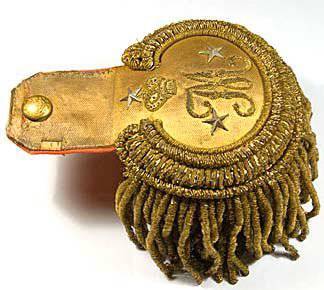 Regarding the monograms on the reader's epaulets, I refer to a separate series of articles. This topic is too diverse and complex to be described in the framework of this article.
Regarding the monograms on the reader's epaulets, I refer to a separate series of articles. This topic is too diverse and complex to be described in the framework of this article.The epaulettes of this sample are worn in units of the Guards infantry, Guards foot artillery, Guards Kirasir regiments, in the Life Guards Saperny Battalion, in the Guards Gendarme Squadron, in the Guards Crew, in the Guards Cossack Parts, in all the cells, in the gauge, in the Guards Crew, in the Guards Cossack units, all of the cells, in the adyr garrison and local engineers), all officers and generals of military departments and institutions, all officers and generals of training units.
In the photo on the right: The epaulette of Lieutenant Colonel 1 of the battery of the Life Guard 2 of the Artillery Brigade. As it should be, the spine, field, neck, fringe and color ciphering of the instrument metal of artillery (gold), podboy red, like all artillery, the monogram of the Highest Chief of the feldtsehmemeister Grand Duke Mikhail Nikolaevich.
Asterisks are silvery overhead.
2. Army infantry epaulettes.
The spine and the field of instrument cloth Color assigned to the shelf. On the spine at the edges galun is sewn with the color of the instrument metal of the regiment (gold or silver). The same tail passes through the field under the neck.
The neck consists of four cords of varying thickness, also the color of the instrument metal of the regiment. Undercut the color of the instrument cloth assigned to the regiment (coincides with the color of shoulder straps for the lower ranks).
Headquarters officers have thin fringe, and generals have thick fringe.
On the field and the spine are stars on the ranks, encryption and who laid special signs.
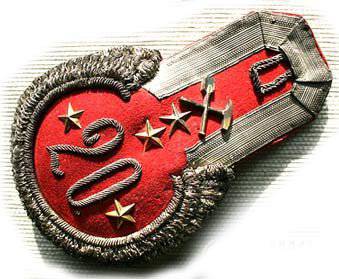 Asterisks are only metal forged overhead in color inverse to instrument metal. They are located - two stars on each side of the encryption on the field, and the third and fourth above the encryption on the back.
Asterisks are only metal forged overhead in color inverse to instrument metal. They are located - two stars on each side of the encryption on the field, and the third and fourth above the encryption on the back.Such epaulettes are carried out by generals and officers of army grenadier and infantry regiments, army foot artillery, army artillery parks, army engineering units, foot Cossack units, and cadet schools.
Special signs of the color of the instrument metal.
Number and letter ciphering embroidered or metal consignment note on the color of the instrument metal.
In the picture on the right: Epoleta of the captain of the 20 th sapper battalion. The root and field are red, as it should be in all engineering troops. The tail is on the spine, the neck is silver (instrument metal of the engineering troops. Encryption (20 number) is embroidered with silver. Gold metal overlay stars. Over the encryption is a special sign of the sapper battalions. There is no fringe as this is the chief officer.
3. Cavalry Epaulettes.
The back of the flake metal of 11 links the color of the instrument metal shelf.
Metal field convex color of the instrument metal shelf.
The neck is similar to an infantry neck and consists of four satellites of varying thickness, also the color of the instrument metal of the regiment.
Headquarters officers have a thin fringe, and the generals have a thick fringe of the same color as the spine and field.
Lining the color of the instrument cloth assigned to the regiment (in the color of shoulder straps for the lower ranks).
On the field and the spine are stars on the ranks (the color of the reverse instrument metal and encryption (the color of the reverse instrument metal ..
Such epaulettes are worn by generals and officers of the guards and army cavalry, with the exception of the cuirassiers and hussars.
Explanation. Cuirassiers generals and officers wear guards infantry epaulettes, and the hussars simply did not have an epaulet, because during the period under review the epaulettes belonged exclusively to the parade uniform, and the hussars due to the characteristics of their parade uniform (dolmans and mentics) wore cords on their shoulders.
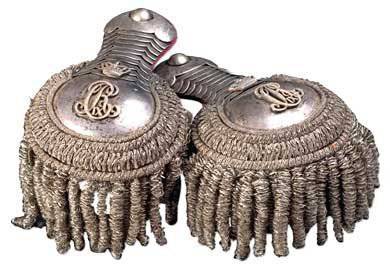 Also, cavalry epaulets are worn by all officers and generals listed for cavalry, officers and generals ofconfigured artillery, generals and officers of Cossack units (except foot Cossacks) and all generals and officers who are assigned a dragoon uniform.
Also, cavalry epaulets are worn by all officers and generals listed for cavalry, officers and generals ofconfigured artillery, generals and officers of Cossack units (except foot Cossacks) and all generals and officers who are assigned a dragoon uniform.On the picture on the right: general epaulettes of a cavalry model. The spine, field, neck and fringe of the regimental metal. Underwear color instrument shelf shelf (red).
On epaulets, a monogram bearing the character of ciphering the color reverse to the instrument metal, i.e. gold.
There are no asterisks, therefore these are epaulets of the cavalry general of the 18 Dragoon Seversk King of the Danish Christian IX Regiment.
From the author. Of course, the 18 dragoon regiment was not commanded by a general of such high rank. However, officers and generals who did not serve in the regiments (in higher headquarters, directorates, departments, etc.) were usually assigned to one of the regiments. More often to those regiments in which they previously served as officers. Therefore, there is nothing surprising in this encryption.
4. Military medical sample.
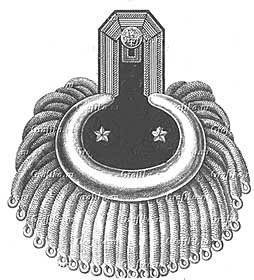 The spine and field are carded or velvet black. The spine is sheathed with silver galloon. The edging on the spine is red.
The spine and field are carded or velvet black. The spine is sheathed with silver galloon. The edging on the spine is red.The neck is not from a harness but a metal forged silver one.
Underbelly epaulet of color of uniform cloth (so-called "royal color", today referred to as "aquamarine").
Military-medical veterinary and staff officers and pharmacists of the officer rank have thin fringe, and general rank have thick fringe.
On the field and the spine are silver stars on the class rank of a military official. And all the stars are located as on epaulets, i.e. officers of officer ranks on one line along the axis of the epaulet ..
Information about the encryption on military-medical epaulettes is not available.
These epaulettes are worn by military medical, military veterinary and pharmaceutical officials.
In the picture on the right: an epaulette of a military physician with the rank of state councilor (class IV according to the Table of Ranks), which is equal to the rank of major general.
Formally, epaulettes on parade uniforms of officers and generals of the Russian Army existed until the moment of the abolition of all orders and insignia at all by the decree of the All-Russian Central Executive Committee and SNK 16 of December 1917, i.e. already a new power.
However, after the start of the First World War in 1914, epaulettes on officer uniforms were rarely seen. Their wearing, as well as wearing ceremonial uniforms, was at first simply considered inappropriate, since the emperor himself walks exclusively in marching form. But freshly baked officers graduating from schools of ensigns and military schools to sew up expensive parade uniforms and acquire more expensive epaulettes were completely useless. They knew they wouldn't have to wear them anyway.
And if we take into account that the personnel officers, especially in the infantry, were almost completely knocked out already in 1915, the epaulettes in fact already went down in history.
Forever.
Even when in the Red Army in 1943, gold galloon shoulder straps gleamed on the shoulders of officers, there was no place for the epaulets. Although there were proposals to introduce epaulets on parade uniforms of the marshals of the Soviet Union, however, they were rejected by the then Soviet leadership. And I think, not because of their high cost and high consumption of gold. It’s just that every kind of uniform and insignia is born and dies in due time. And epaulettes by the middle of the 20th century would have looked like an anachronism.
PS
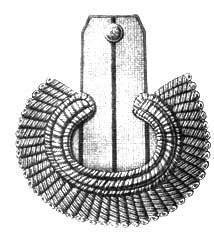 Sometimes there are some very strange epaulets on the Internet that lead many to bewilderment. Fringe Generals, and on the spine and the field of the epaulet passes through the gap like the chief officers.
Sometimes there are some very strange epaulets on the Internet that lead many to bewilderment. Fringe Generals, and on the spine and the field of the epaulet passes through the gap like the chief officers. 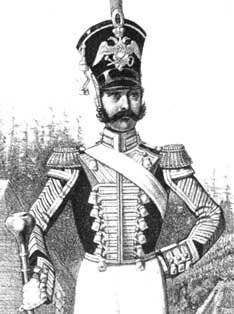 In reality, these are the epaulettes of the chain-seal in the guard regiments, i.e. conductor of the sergeant-major level regimental orchestra. Chin existed from 1815 to 1881 year. And these epaulettes were introduced in April 1843
In reality, these are the epaulettes of the chain-seal in the guard regiments, i.e. conductor of the sergeant-major level regimental orchestra. Chin existed from 1815 to 1881 year. And these epaulettes were introduced in April 1843On the picture to the right: Tambour major of the Life Guard of the Lithuanian regiment. 1844
The stub and field of the epaulette is gold or silver (according to the color of the instrument metal of the regiment) of the small block pattern. Clearance and hemming in color shoulder straps of the lower ranks of the regiment.
Actually, such epaulets were earlier a bit earlier, and in 1843 a gap appeared on them, so that there were more differences from a purely general epaulet.
The epaulette carried no semantic load, but was a purely decorative element of the parade form as well as a “porch” on the shoulders and the interlacing with galunous chevrons of the sleeveless uniform.
It is also worth noting that for the first time the stars on the epaulets, denoting the ranks, appeared not in the army or in the guard, but in the departments of mining and communications, where in addition to civilian officials there were officers. The system of distinguishing ranks using stars on epaulets appeared in these departments as early as 1809 or 1810, and was more logical than the one that was introduced into the army in 1827.
Epaulettes without fringe:
* ensign - without asterisks,
* second lieutenant - 1 asterisk,
* Lieutenant - 2 stars,
* Staff Captain - 3 stars.
Fringe epaulettes
* Major - 1 asterisk,
* Lt. Col. 2 asterisks,
* Colonel - 3 stars.
Thick fringe epaulettes:
* Major General - 1 asterisk,
* Lieutenant-General - 2 asterisks,
* Engineer-General - 3 stars.
In 1827, this system of insignia in departments was replaced by an army one.
Sources and Literature
1. Historical description of clothing and weapons of Russian troops. Part Four Issued by the Main Directorate of Quartermaster Directorate. St. Petersburg 1899
2. Historical description of clothing and weapons of Russian troops. Part Five Issued by the Main Directorate of Quartermaster Directorate. St. Petersburg 1899
3. Historical description of clothing and weapons of Russian troops. Part six. Issued by the Main Directorate of Quartermaster Directorate. St. Petersburg 1900
4. Historical description of clothing and weapons of Russian troops. Part Seven. Issued by the Main Directorate of Quartermaster Directorate. St. Petersburg 1900
5. Historical description of clothing and weapons of Russian troops. Part Eight Issued by the Main Directorate of Quartermaster Directorate. St. Petersburg 1900
6. Historical description of clothing and weapons of Russian troops. Part nine. Issued by the Main Directorate of Quartermaster Directorate. St. Petersburg 1900
7. Historical description of clothing and weapons of Russian troops. Part ten. Issued by the Main Directorate of Quartermaster Directorate. St. Petersburg 1900
8. Historical description of clothing and weapons of Russian troops. Part eleventh. Issued by the Main Directorate of Quartermaster Directorate. St. Petersburg 1900
9. MM Khrenov and others. Military clothes of the Russian Army. Military publishing. Moscow. 1994
10.O.Leonov, I.Ulyanov. Regular infantry 1698-1801. AST.Moskva. 1995
11.I.Golyzhenkov, B.Stepanov. European soldier for 300 years. Isographus. Eksmo-Press. Moscow.2001g.
12. Site www.litulan.ru/rekmnd/rekmnd1.php
13. Historical description of clothing and weapons of Russian troops. Part twelfth. Issued by the Main Directorate of Quartermaster Directorate. St. Petersburg 1900
14. Historical description of clothing and weapons of Russian troops. Part thirteen. Issued by the Main Directorate of Quartermaster Directorate. St. Petersburg 1901
15. Historical description of clothing and weapons of Russian troops. Part fourteen. Issued by the Main Directorate of Quartermaster Directorate. St. Petersburg 1901
16. Historical description of clothing and weapons of Russian troops. Part fifteen. Issued by the Main Directorate of Quartermaster Directorate. St. Petersburg 1901
17. Historical description of clothing and weapons of Russian troops. Part Sixteen. Issued by the Main Directorate of Quartermaster Directorate. St. Petersburg 1902
18. Historical description of clothing and weapons of Russian troops. Part seventeen. Issued by the Main Directorate of Quartermaster Directorate. St. Petersburg 1902
19. Historical description of clothing and weapons of Russian troops. Part Eighteenth. Issued by the Main Directorate of Quartermaster Directorate. St. Petersburg 1902
20. Historical description of clothing and weapons of Russian troops. Part nineteenth Issued by the Main Directorate Quartermaster Directorate. St. Petersburg 1902
21. Historical description of clothes and weapons of Russian troops. Tom 20. Artillery Museum. Novosibirsk 1944.
22. V.K.Shenk Rules of the Formation of Clothing by Officers of the Armed Forces and Civil Ranks of the Military Department. St. Petersburg 1910.
23. S.M.Goryainov. Charters of conscription. Commission of military educational institutions. St. Petersburg 1913.
24.Table reference book for the front officer officers. Typography of the Troops of the Guard and the St. Petersburg Military District. St. Petersburg 1913.
25. Historical description of clothes and weapons of Russian troops. Tom 21. Artillery Museum. Novosibirsk 1944.
Information